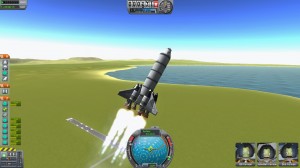Several members of the Houghton Physics Department introduced me a few weeks ago to Kerbal Space Program, an indie sandbox space flight simulator program. In this game, you can build various flying vehicles, including rockets and airplanes, and pilot them above the earth, into space, and even to other planets.

Though it is still in the beta stage of its development, this simulation game has many features that create a worthwhile player experience. These game elements include a large toolkit of vehicle parts, numerous planets and moons to travel to and land upon, and a system of game elements that allow players to undertake a wide variety of missions.
Since it is still in beta, the developers continue to add features. Already, a vibrant player community has developed and has produced many game modifications and add-ons.
Once in the game, you have the option of building your own vehicle or selecting a pre-made sample rocket or airplane for modification and testing. In the building process, the program assists with the proper alignment and orientation of vehicle parts according to various symmetry modes. This means that rocket boosters, jet engines, fins, and other parts can be evenly spaced on the vehicle, allowing for balanced control during flight.
As soon as your ship is ready to fly, you can enter the launch mode of the game. In this mode, you have control over the engines, staging sequence, electronic systems, and other deployable items. The passengers of this craft are small, greenish-yellow aliens called Kerbals.
These strange little people do not provide assistance in the mission, but do provide some laughs as they react wildly to the player’s actions in controlling the ship. Some of these passengers become easily panicked by even subtle shifts in the ship’s trajectory. Others are in a constant state of ecstasy, even when their conveyance is on its way to a fiery and explosive demise.
Once your ship lands on a planet or moon, the Kerbals can explore. The universe provided to the player is currently limited to a solar system much like our own.
You begin your missions on Kerbin, an Earth-like world that has several moons. The other planets in this solar system mirror the planets in our own solar system, including several gas giants with many moons, and a few terrestrial planets. In the missions you design for yourself, you can visit the terrestrial worlds and the moons of this solar system.
In order to travel to the other celestial orbs in the Kerbal solar system, the game provides a system of flight mechanics that allows for easier orbit manipulation called the maneuvers system. This system allows you to reach almost anywhere in the solar system without performing calculations. Because of systems like these, it is not difficult to get started with space exploration in Kerbal Space Program.
Several of my friends have launched numerous rockets with a variety of payloads into orbit around Kerbin, and have docked their vehicles together to create space stations. The process of bringing the vehicles into the same orbit, and eventually docking them involves time and effort, but it is rewarding, as it allows for further exploration of the Kerbal solar system.
Currently, Kerbal Space Program, is available from the Kerbal Space program store at: www.kerbalspaceprogram.com in a demo version and a full version that costs $23. Because it is being constantly updated, has an active modding community, and already includes features that enable the player to perform a variety of missions that are only limited by the player’s imagination, this simulation game is certainly worth checking out.
